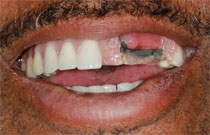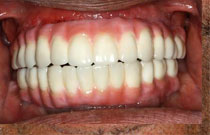Call: 707.525.1600 1100 Sonoma Ave. Suite D. Santa Rosa, CA 95405 No Insurance, No Problem - Learn more
About Periodontal Disease
Periodontal diseases are infections of the gums that gradually destroy the support of your natural teeth. Dental plaque is the primary cause of gum disease in genetically-susceptible individuals. Bacteria found in plaque produce toxins or poisons that irritate the gums. They may cause them to turn red, swell, and bleed easily. If this irritation is prolonged, the gums separate from the teeth causing pockets (spaces) to form. Plaque can also harden into a rough, porous substance known as calculus (or tartar). This can occur both above and below the gum line.
As periodontal diseases progress, the supporting gum tissue and bone that holds teeth in place deteriorate. If left untreated, this leads to tooth loss.
However, don’t be fooled. With periodontal disease, bleeding, redness, and swelling do not have to be present. Further, pain is usually not associated with periodontal disease. This disease damages the teeth, gum, and jawbone of more than 80 percent of Americans by age 45.



